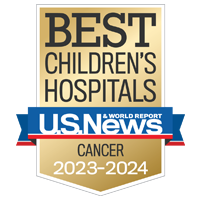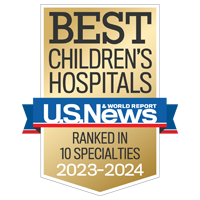Feeling at home
From bedside bingo to therapy dogs, we're here to help kids smile and feel more like themselves.
Visit Child Life services

Wilms' tumor is a type of childhood cancer that occurs in the kidneys. The kidneys are a pair of kidney bean-shaped organs, located above the waist on either side of the spine, that filter and clean blood and produce urine.
Wilms' tumor also is called nephroblastoma, for nephro, meaning kidney, blast, meaning primitive cell and oma, meaning tumor. It is the fifth most common childhood cancer and one of the most common tumors of the abdomen in children. About 400 children in the United States are diagnosed with Wilms' tumor each year. The disease, which affects boys and girls equally, can occur at any age between infancy and 15 years, although it's usually diagnosed by age 3.
Typically it occurs in one kidney but occasionally involves both. If the cancer spreads, it usually spreads to the lungs and liver. With treatment, many children can have a good prognosis for recovery.
Generally, the condition causes a painless swelling in the abdomen and is discovered while bathing, dressing or changing the diapers of your child. Some children may have bloody urine, abdominal pain, loss of appetite, fatigue or weight loss.
If a tumor is suspected in your child's abdomen, don't apply pressure to this area. Careful bathing and handling of your child is important before and during any tumor evaluation. If the tumor ruptures, cancer cells could spread to other tissues of the body.
To request an appointment, give us a call.
Children with Wilms' tumor may experience many different symptoms. The following, however, are the most common:
Your child's doctor will conduct a complete medical history and physical examination. Diagnostic procedures may include:
In the diagnosis of Wilms' tumor, the appearance of cancer cells under a microscope is very important. Wilms' tumors generally are categorized by five stages as well as recurrent disease. The categories are as follows:
Surgery, chemotherapy and radiation therapy are common treatments for Wilms' Tumor, depending on the stage of the cancer and the condition of your child.
Surgery is a common treatment for Wilms' tumor. Your child's doctor may take out the cancer using one of the following:
Chemotherapy is the use of drugs to kill cancer cells. It may be taken by pill or may be put into the body by a needle in a vein or muscle. Chemotherapy is called a systemic treatment because drugs enter the bloodstream, travel through the body and can kill cancer cells throughout the body. Chemotherapy given after an operation, when there are no known remaining cancer cells, is called adjuvant therapy.
When very high doses of chemotherapy are used to kill cancer cells, these high doses can destroy the bone marrow, the blood-forming tissue in the bones. If very high doses of chemotherapy are needed to treat the cancer, bone marrow may be taken from the bones before therapy and frozen until it is needed. Following chemotherapy, the bone marrow is returned through a needle in a vein. This is called autologous bone marrow reinfusion.
Radiation therapy uses X-rays or other high-energy rays to kill cancer cells and shrink tumors. Radiation for Wilms' tumor usually comes from a machine outside the body, also called external radiation therapy. Radiation may be used before or after surgery and chemotherapy.
After several years, some patients develop a second, different form of cancer as a result of treatment with chemotherapy and radiation. Clinical trials are underway to determine if lower doses of chemotherapy and radiation can be used.
Treatment depends on the stage of the disease, cell type or histology and your child's age and general health. Treatment may be standard, based on its effectiveness in a number of patients in past studies, or experimental. Your doctor may propose that your child participate in a clinical trial, a research project involving experimental treatments. Not all patients are cured with standard therapy and some standard treatments may have more side effects than are desired. For these reasons, clinical trials are designed to test new, better treatments.
If the tumor has a "favorable" cell type or if your child has anaplastic Wilms' tumor, your child's treatment will probably involve surgery to remove the cancer followed by chemotherapy. If your child has either clear cell sarcoma of the kidney or rhabdoid tumor, treatment will probably involve surgery followed by radiation therapy and chemotherapy.
If the tumor has a "favorable" cell type, your child's treatment will probably involve surgery to remove the cancer followed by chemotherapy. If your child has an "unfavorable" cell type such as anaplasia, clear cell sarcoma or rhabdoid tumor of the kidney, treatment may involve surgery followed by radiation therapy and chemotherapy.
Treatment will probably involve surgery, followed by radiation therapy and chemotherapy. Sometimes, the cancer cannot be removed by surgery because it is too close to important organs or blood vessels or because it is too large. In these cases, the doctor may perform a biopsy only and then suggest chemotherapy with or without radiation. Once the cancer is reduced by treatment, surgery may be performed, followed by additional chemotherapy and radiation therapy.
Treatment will probably involve surgery, followed by radiation therapy and chemotherapy. If the cancer has metastasized or spread to the lungs, your child will receive additional chemotherapy.
In this stage, both kidneys contain cancer. Usually, it isn't possible to remove both kidneys. Your child's doctor may remove a piece of the cancer from both kidneys and remove some of the surrounding lymph nodes to see if they contain cancer. Following surgery, chemotherapy is given to shrink the cancer. After the cancer is reduced, a second operation is performed to remove as much of the cancer as possible, while leaving as much of the kidneys as possible. Surgery may be followed by more chemotherapy and radiation therapy.
If your child's cancer recurs, treatment will depend on the treatment he or she received before, how much time has passed since the treatment, the cancer cell type and where the cancer emerges. Depending on these factors, treatment may involve surgery, radiation therapy and chemotherapy.
Clinical trials — research projects involving patients — help to evaluate new treatments, such as chemotherapy drugs, new combinations of treatments and bone marrow reinfusion.
UCSF Benioff Children's Hospitals medical specialists have reviewed this information. It is for educational purposes only and is not intended to replace the advice of your child's doctor or other health care provider. We encourage you to discuss any questions or concerns you may have with your child's provider.
A Study of Combination Chemotherapy for Patients With Newly Diagnosed DAWT and Relapsed FHWT
For Strata 1-3, the primary analysis of EFS will consist of a one-sample, one-sided log rank test versus a historical control cohort (or representative distribution) with stratum-specific type I error levels. For Stratum 4, the pr...
Recruiting
More about this study
Best in Northern California for cancer care

Ranked among the nation's best in 10 specialties
Feeling at home
